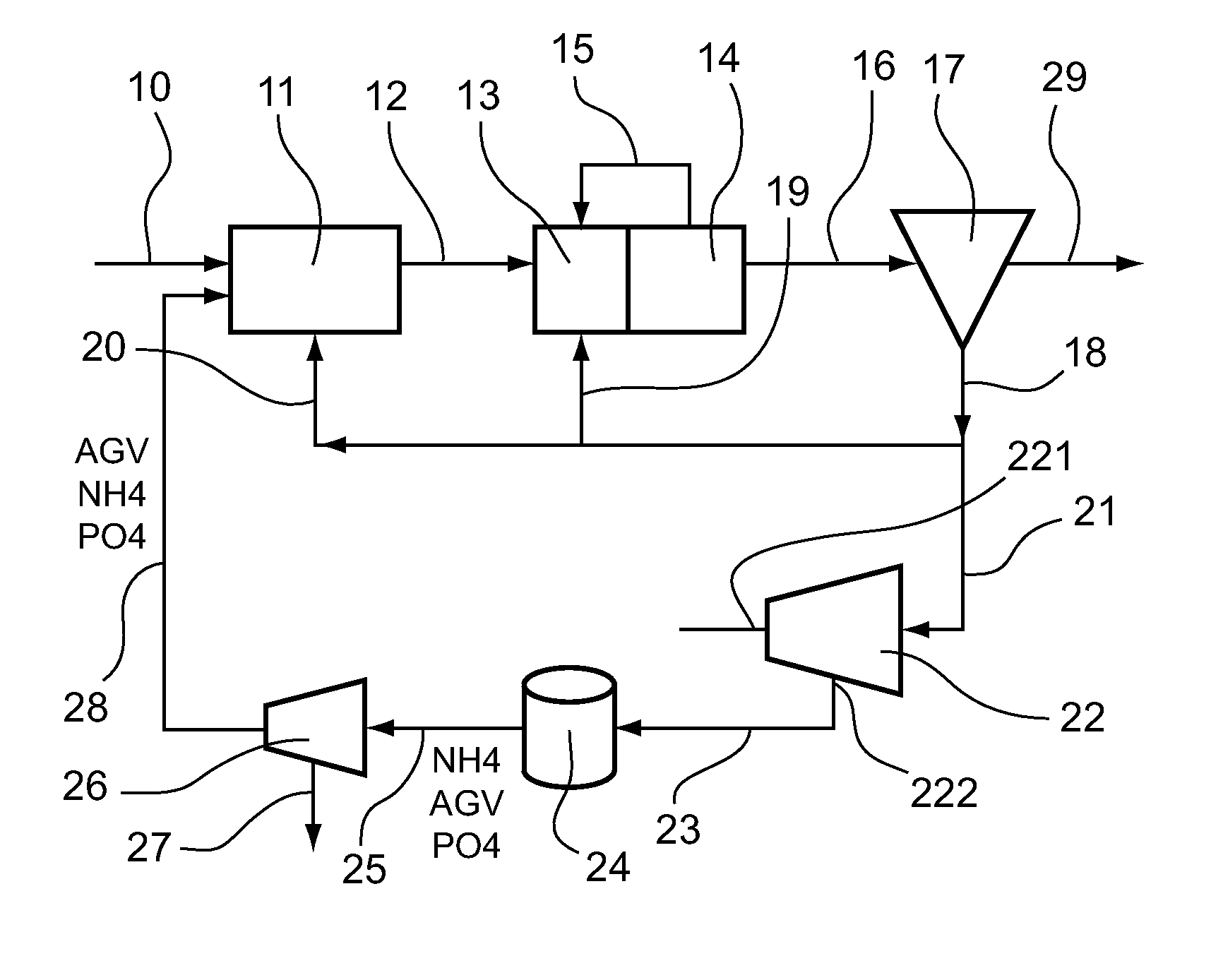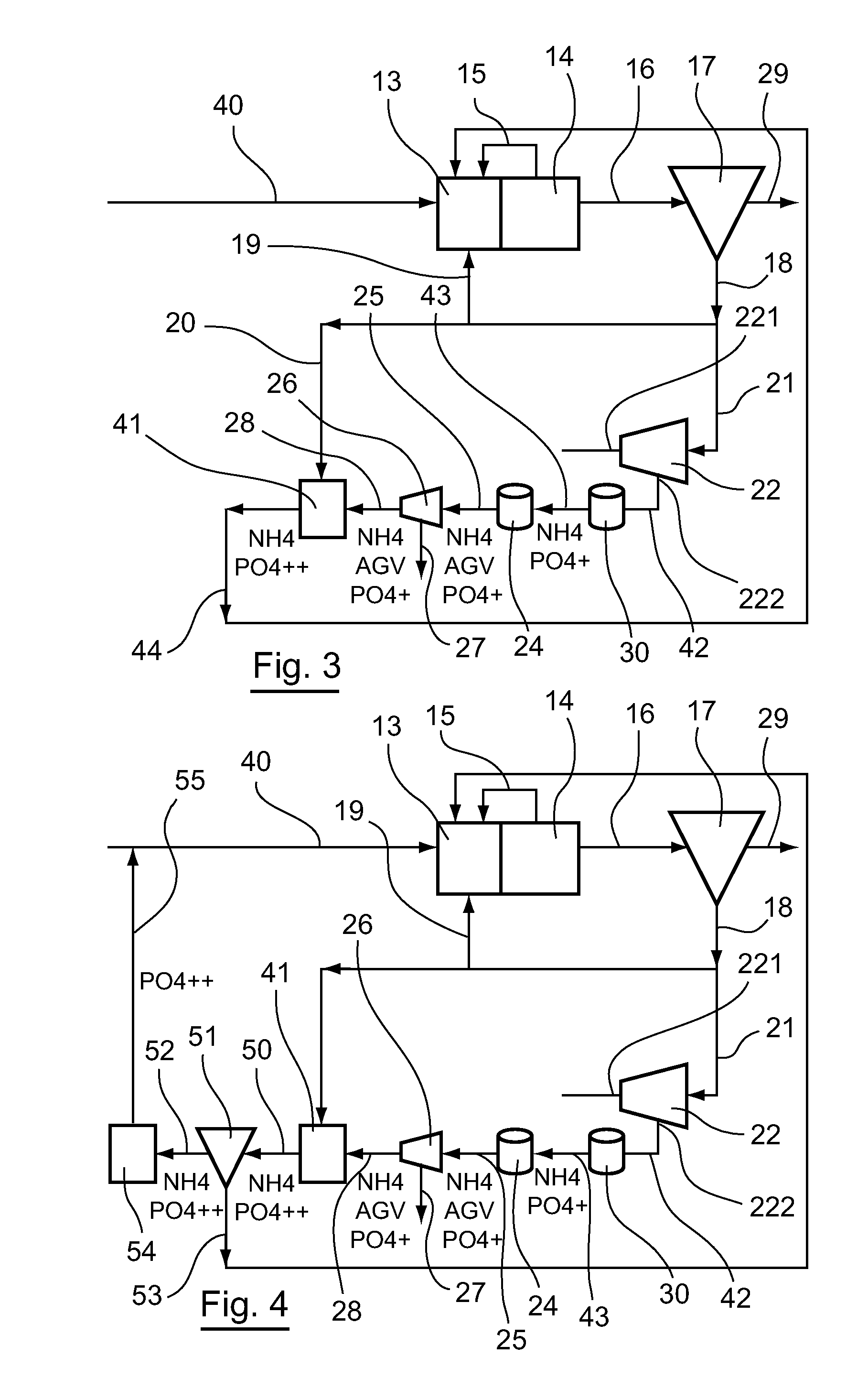Process for treating an effluent for the purpose of bringing down the phosphate content thereof, comprising a step of optimized wet heat treatment, and corresponding equipment
a technology of wet heat treatment and effluent, which is applied in the direction of water/sludge/sewage treatment, filtration separation, specific water treatment objectives, etc., can solve the problems of increasing the quantity of sludge formed during the treatment of water, having a negative environmental impact in terms of carbon footprint, and requiring the use of additional, bulky and costly technical means dedicated solely to production, so as to promote paos and reduce phosphates
- Summary
- Abstract
- Description
- Claims
- Application Information
AI Technical Summary
Benefits of technology
Problems solved by technology
Method used
Image
Examples
first embodiment
7.2. Example of the Invention
[0074]7.2.1. Plant
[0075]Referring to FIG. 1, we present an embodiment of a plant for treating water according to the invention.
[0076]Thus, as represented in this figure, such a plant comprises a pipe 10 for conveying water to be treated. This pipe 10 leads into the inlet of an anaerobic biological treatment zone 11.
[0077]This anaerobic biological treatment zone 11 comprises a biological reactor within which dephosphating PAO microorganisms develop when anaerobic conditions are maintained. This treatment zone 11 comprises an outlet which is connected by means of a pipe 12 to the inlet of an anoxic biological treatment zone 13.
[0078]An anoxic biological treatment zone 13 comprises a biological reactor within which denitrifying microorganisms develop when anoxic conditions are maintained. This anoxic biological treatment zone 13 comprises an outlet which is connected to the inlet of an aerobic biological treatment zone 14.
[0079]This aerobic biological treat...
second embodiment
7.3. Example of the Invention
[0110]7.3.1. Plant
[0111]Referring to FIG. 2, we present a plant according to a second embodiment.
[0112]The plant illustrated in FIG. 2 is distinguished from the one illustrated in FIG. 1 by the fact that it comprises in addition an anaerobic digester 30 interposed between the outlet of the concentrator 22 and the inlet of the wet heat treatment 24, to the inlet of which it is connected by means of a pipe 31.
[0113]7.3.2. Method
[0114]An example of a method according to the invention implementing a plant described with reference to FIG. 2 is now described.
[0115]Such a method is distinguished from the one described here above by the fact that the concentrated sludges coming from the concentrator 22 are conveyed via the pipe 23 to the anaerobic digester 30.
[0116]These sludges therein undergo an anaerobic digestion which leads to the formation and extraction of biogas and a sludge containing residual organic matter, ammoniacal nitrogen and phosphates. This slu...
third embodiment
7.4. Example of the Invention
[0118]7.4.1. Plant
[0119]Referring to FIG. 3, we present a plant according to a third embodiment.
[0120]As shown in this FIG. 3, such a plant comprises a water inlet pipe 40. This pipe 40 leads into the inlet of an anoxic biological treatment zone 13.
[0121]This anoxic biological treatment zone 13 comprises a biological reactor within which anoxic conditions are maintained so that the development of denitrifying microorganisms is fostered. This anoxic biological treatment zone 13 comprises an outlet that is connected to the inlet of an aerobic biological treatment zone 14.
[0122]This aerobic biological treatment zone 14 comprises a biological reactor that houses aeration means such as an air or oxygen distributor, within which aerobic conditions are maintained so that the development of the nitrifying microorganisms is promoted. This aerobic biological treatment zone 14 comprises a first outlet that is linked via a recirculation pipe 15 to the anoxic biologi...
PUM
| Property | Measurement | Unit |
|---|---|---|
| Temperature | aaaaa | aaaaa |
| Temperature | aaaaa | aaaaa |
| Temperature | aaaaa | aaaaa |
Abstract
Description
Claims
Application Information
 Login to View More
Login to View More - R&D
- Intellectual Property
- Life Sciences
- Materials
- Tech Scout
- Unparalleled Data Quality
- Higher Quality Content
- 60% Fewer Hallucinations
Browse by: Latest US Patents, China's latest patents, Technical Efficacy Thesaurus, Application Domain, Technology Topic, Popular Technical Reports.
© 2025 PatSnap. All rights reserved.Legal|Privacy policy|Modern Slavery Act Transparency Statement|Sitemap|About US| Contact US: help@patsnap.com



